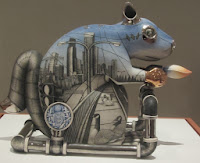A legendary musician, a venerated movie director and little
ceramic figurines. All are featured in recent exhibits in Toronto that explore
storytelling from different angles.
Having its North American debut in Toronto, the David Bowie
exhibition was one of the most exciting exhibits ever to come out of the
Victoria and Albert Museum in London.
A retrospective of David Bowie’s life and career featuring
more than 300 objects from Bowie’s personal archive -- including more than 50
stage costumes, a variety of props (even the scepter from Labyrinth!), personal
notes and rare videos -- was displayed at the AGO until the end of November. The
exhibit is “an immersive multimedia show” that explores Bowie’s work, influence
and collaborations in the fields of fashion, sound, theatre, art and film. Its
next stop is São Paulo, Brazil.
 |
| via Torontoist |
 |
| via Torontoist |
Bowie has always been a transgressive artist and the exhibit
explores how he blurred the lines of gender, art, music and performance,
creating a one-man revolution that transformed pop culture forever and made him
an icon. Whether he is changing the world or
hawking a purse, David Bowie still is.
“All art is unstable. Its meaning is not necessarily that
implied by the author. There’s no authoritative voice. There are only multiple
readings.” (Bowie)
Another man who has blurred boundaries and told us
incredible stories – the man who brought us heads exploding, a man turning into a fly, Viggo Mortensen fighting naked in a sauna and all kinds of penis- and vagina-shaped parasites and devices – is showing his wares at the Tiff Lightbox
until early next year. One of the most versatile storytellers of our times,
David Cronenberg has been called perverse, disgusting and repulsive, and is
also one of the most acclaimed, provocative and influential contemporary
Canadian directors.
 |
| via The Star |
The exhibition, appropriately titled Evolution, traces not
only the 70-year-old Toronto-born director’s filmographic evolution (from porn-y B-movies
with plenty of blood and viscera to more cerebral and serious latter fare), but
also the trajectory of a filmmaker always searching for new ways to explore his
interests in science fiction, psychology, literature, biotechnology, sex and
the dark side of human nature.
His tales took a different turn in 1991, with his adaptation
of the “unfilmable” William Burroughs’ novel Naked Lunch. Like David Bowie,
Cronenberg also looked for inspiration in Burroughs and Beat literature.
Cronenberg gave life to mugwumps, the Interzone, typewriter beetles with talking anuses and some other scary and dystopic scenarios. He then evolved a
new layer in his directorial work with more psychological material, starting
with 2002’s Spider, a scary story with no talking orifices or flat out
gross-outs, all the way to 2012’s Cosmopolis, where he -- accidentally or not
-- captured the zeitgeist of the Occupy Wall Street movement, from inside a
limousine, no less.
David Cronenberg has also self-admittedly always thought of being a novelist. He has been telling stories for the past 40
years, sometimes his own, sometimes someone else’s, and -- also like Bowie -- he is a
transgressive artist, bringing plenty of controversial and subversive
sensibilities to the material he touches. His black humor, gender exploration and
dark sexual fantasies are always present, from fetishistic car-crash seekers to
the birth of the dangerous methods of psychoanalysis, from video game sockets that connect straight to your rear end to creatures that excrete addictive
drugs from tubes in their heads.
I ended my exhibit circuit at the Gardiner Museum, an
often-overlooked gem located in
Toronto across the street from the flashier and more recognized ROM.
The Gardiner is Canada’s national ceramics museum, with a
collection consisting of more than 3,000 pieces. The current exhibit, Animal Stories, explores our fascination with animals and how their narratives have
been illustrated in the often-forgotten medium of ceramics.
(more pics on Tumblr)
In this exhibit there are pictures of exotic creatures,
household pets, mythical beasts and a few endangered species, representing “our
encounters with the animal world, shedding light on how our social, symbolic,
affectionate, scientific and utilitarian relationships” with them.
We are also introduced to many creatures with characters
like Peter Rabbit, Clara the rhinoceros, and Jumbo the elephant (who,
surprisingly, died in St. Thomas, Ontario, where there’s a memorial and statue
of the departed celebrity elephant.) The exhibition also features illustrated
books alongside ceramics, “exploring the longstanding connection between the
two media as vehicles for storytelling.” The work of Toronto-based author and
illustrator Barbara Reid stood out, with her use of plasticine to actually
sculpt her illustrations.
All in all a curious, charming and interesting exhibit for children and adults, that
resonated with the words of Charles Darwin:
“The love for all living
creatures is the most noble attribute of man.”



























0 comments:
Post a Comment